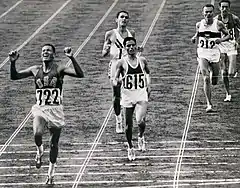
Equipment used for putting chalk lines on a cinder track.

Billy Mills winning the 10,000 metres at the 1964 Summer Olympics, the last Olympics to be held on a cinder track
A cinder track is a type of race track, generally purposed for track and field or horse racing, whose surface is composed of cinders. For running tracks, many cinder surfaces have been replaced by all-weather synthetic surfaces, which provide greater durability and more consistent results, and are less stressful on runners. The impact on performance as a result of differing track surfaces is a topic often raised when comparing athletes from different eras.[1][2]
Synthetic tracks emerged in the late 1960s; the 1964 Olympics were the last to use a cinder track.[3]
The Little 500 bicycle race at Indiana University is still run annually on a cinder track.
References
- ↑ "cinder-track vs. all-weather track times". Letsrun.com. Retrieved 2011-09-14.
- ↑ "Track & Field News • View topic - Kip Keino's 3.34.9 at altitude 1968". Trackandfieldnews.com. Archived from the original on 2012-03-27. Retrieved 2011-09-14.
- ↑ Olympic.org - Tokyo 1964 - accessed 2011-08-09
This article is issued from Wikipedia. The text is licensed under Creative Commons - Attribution - Sharealike. Additional terms may apply for the media files.